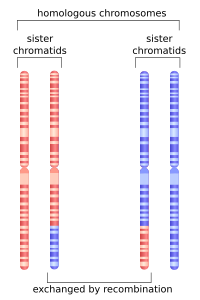
Photo from wikipedia
BACKGROUND Meiosis is an essential stage in the life cycle of sexually reproducing species, underlying formation of haploid gametes and serving as the basis of genetic diversity. A central mechanism… Click to show full abstract
BACKGROUND Meiosis is an essential stage in the life cycle of sexually reproducing species, underlying formation of haploid gametes and serving as the basis of genetic diversity. A central mechanism of meiosis is recombination between homologous chromosomes, during which programmed DNA double-strand breaks (DSBs) are sequentially repaired to form the crossovers essential for faithful chromosomal segregation. Aberrant meiotic recombination often leads to gametogenic failure or produces aneuploid gametes resulting in subfertility or infertility, miscarriage or birth defects. OBJECTIVE AND RATIONALE The goal of this review was to characterize the molecular mechanisms of meiotic recombination and related human infertility disorders, particularly male infertility caused by non-obstructive azoospermia (NOA). SEARCH METHODS Our search included PubMed database articles, focusing mainly on English-language publications dated between January 2016 and February 2022. The search term 'meiosis' was combined with the following keywords: meiotic initiation, chromosome pairing, homologous recombination, chromosome axis, DSB, DSB repair, crossover, meiotic sex chromosome inactivation, meiotic checkpoints, meiotic arrest, NOA, premature ovarian insufficiency (POI) or premature ovarian failure, treatment and cancer. In addition, references within these articles were used to identify additional studies. OUTCOMES The preliminary search generated ∼3500 records. The majority of articles were identified as meeting abstracts or duplicates, contained non-English text or provided insufficient data and were therefore eliminated. A total of 271 articles associated with meiotic recombination were included in the final analysis. This review provides an overview of molecules and mechanisms involved in meiotic recombination processes, specifically meiosis-specific chromosome structures, DSB formation, homology search, formation of recombination intermediates and crossover formation. The cumulative results suggest that meiosis is regulated sequentially by a series of meiotic recombination genes and proteins. Importantly, mutations in these genes often affect meiotic progression, activating meiotic checkpoints, causing germ cell arrest and leading to subfertility or infertility. At least 26 meiotic recombination-related genes have been reported to be mutated in NOA in men, and 10 of these genes are mutated in POI in women. This suggests that variants of meiotic recombination-related genes can cause human subfertility or infertility, especially NOA. WIDER IMPLICATIONS Understanding the processes of homologous chromosome pairing, recombination and timely resolution of homologous chromosomes may provide guidance for the analysis of potential monogenetic causes of human subfertility or infertility and the development of personalized treatments. In clinical practice, we can develop a meiotic recombination-related gene panel to screen for gene mutations in individuals with subfertility or infertility. Testicular sperm extraction should not be recommended when an NOA-affected individual carries definite disease-causing mutations of a meiotic gene, so as to avoid the unnecessary invasive diagnosis. Risk of ovarian dysfunction should be evaluated if a woman carries meiotic recombination-related gene mutations. It may be possible to improve or restore fertility through manipulation of meiotic recombination-related genes in the future.
Journal Title: Human reproduction update
Year Published: 2022
Link to full text (if available)
Share on Social Media: Sign Up to like & get
recommendations!